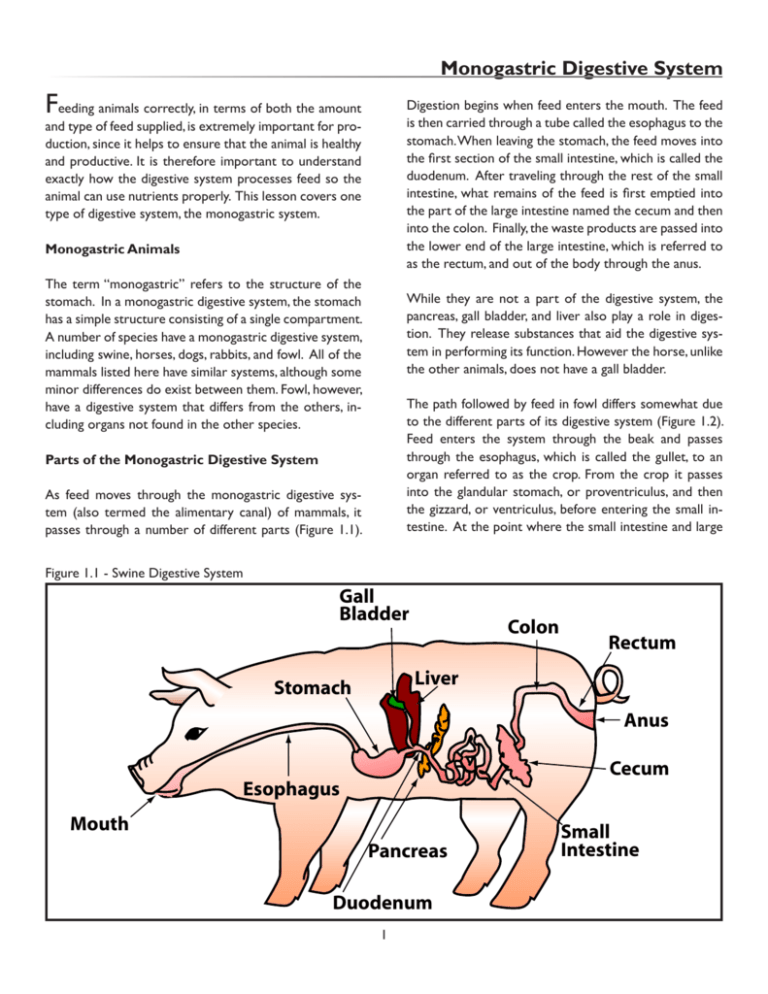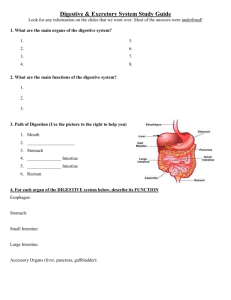Monogastric Digestive System
advertisement

Monogastric Digestive System Feeding animals correctly, in terms of both the amount Digestion begins when feed enters the mouth. The feed is then carried through a tube called the esophagus to the stomach. When leaving the stomach, the feed moves into the first section of the small intestine, which is called the duodenum. After traveling through the rest of the small intestine, what remains of the feed is first emptied into the part of the large intestine named the cecum and then into the colon. Finally, the waste products are passed into the lower end of the large intestine, which is referred to as the rectum, and out of the body through the anus. and type of feed supplied, is extremely important for production, since it helps to ensure that the animal is healthy and productive. It is therefore important to understand exactly how the digestive system processes feed so the animal can use nutrients properly. This lesson covers one type of digestive system, the monogastric system. Monogastric Animals The term “monogastric” refers to the structure of the stomach. In a monogastric digestive system, the stomach has a simple structure consisting of a single compartment. A number of species have a monogastric digestive system, including swine, horses, dogs, rabbits, and fowl. All of the mammals listed here have similar systems, although some minor differences do exist between them. Fowl, however, have a digestive system that differs from the others, including organs not found in the other species. While they are not a part of the digestive system, the pancreas, gall bladder, and liver also play a role in digestion. They release substances that aid the digestive system in performing its function. However the horse, unlike the other animals, does not have a gall bladder. The path followed by feed in fowl differs somewhat due to the different parts of its digestive system (Figure 1.2). Feed enters the system through the beak and passes through the esophagus, which is called the gullet, to an organ referred to as the crop. From the crop it passes into the glandular stomach, or proventriculus, and then the gizzard, or ventriculus, before entering the small intestine. At the point where the small intestine and large Parts of the Monogastric Digestive System As feed moves through the monogastric digestive system (also termed the alimentary canal) of mammals, it passes through a number of different parts (Figure 1.1). Figure 1.1 - Swine Digestive System Gall Bladder Colon Rectum Liver Stomach Anus Cecum Esophagus Mouth Pancreas Duodenum 1 Small Intestine Introduction to Animal Nutrition Figure 1.2 - Digestive System of Fowl some species it has little or no effect on digestion. In the horse and rabbit, however, the cecum is enlarged, which allows the microorganisms to ferment roughage, which is feed (like hay, grass, and grass products) that has a lot of fiber and few digestible nutrients. The fermentation breaks down the roughage for absorption into the blood. These two species are therefore able to make efficient use of plant materials in their diets. After passing through the cecum, the feed enters the colon, which absorbs water and forms the feces. Some nutrients are absorbed in the colon as well. The parts allowing the exit of the feces are the rectum and the anus. The rectum carries the feces to the anus. The anus passes the solid wastes out of the body. intestine join are two ceca. After passing the ceca, the undigested material moves through the large intestine to the cloaca and exits the body through the vent. The digestive system of fowl functions somewhat differently. Fowl have no teeth with which to chew and instead use the beak to break feed down for swallowing. After passing through the gullet, feed is stored in the crop and softened for digestion before it enters the stomach. Digestion begins in the glandular stomach. The feed then passes into the gizzard where it is ground by muscular contractions before entering the small intestine for digestion and absorption. The two ceca contain bacteria but have little role in digestion; fowl therefore cannot digest fibrous feeds like hay.The large intestine carries wastes to the cloaca, the junction of the reproductive and digestive systems. The vent allows wastes to exit the body. Functions of the Parts The parts of the mammalian monogastric digestive system can be divided into four sections based on their functions. The sections consist of the parts leading to the small intestine, the small intestine, the large intestine, and the parts allowing the exit of solid wastes, or feces. The parts leading to the small intestine reduce the size of feed particles. The process begins in the mouth as the teeth are used to grind feed into smaller pieces that are moved to the throat by the tongue. The tubelike esophagus carries these pieces to the stomach, a muscular organ that stores food before it passes into the small intestine. Digestion, which began in the mouth, continues in the stomach. Digestive Juices and Enzymes Digestion is the breakdown of food into soluble particles that can then be passed through the intestinal wall and absorbed into the blood system for use by the animal. Digestive juices and enzymes play a major role in digestion. The primary function of the small intestine is to further break down and absorb the nutrients found in food. The digestive processes continue in the duodenum. Nutrients are absorbed into the bloodstream through the intestinal walls in the remainder of the small intestine. Digestive juices are fluids that are secreted into the digestive system from glands or tissues. Substances call enzymes are found in these fluids. An enzyme speeds up chemical reactions, allowing feed to be digested and absorbed. Table 1.1 shows digestive juices and enzymes found in the monogastric digestive system. The next section of the digestive system, which consists of most of the large intestine, is designed to absorb water and mold indigestible feed wastes into a solid form. The cecum, also referred to as the blind gut, contains microorganisms. Its function varies depending on the species. In In mammals, digestive juices begin to break down feed as soon as it enters the mouth. Saliva from the salivary 2 Monogastric Digestive System Table 1.1 - Digestive Juices and Enzymes Type of Digestive Juices Saliva Gastric Pancreatic Bile Intestinal the enzymes peptidase, maltase, sucrase, and lactase are produced in the small intestine itself. Peptidase breaks down proteins, while maltase, sucrase, and lactase work on sugars and starches. Enzyme Amylase Pepsin Rennin Lipase Amylase Lipase Trypsin Chymotrypsin No enzyme present Peptidase Maltase Sucrase Lactase In fowl, digestive juices also convert the nutrients in feed into a usable form. Little saliva is present in the mouth, but saliva and secretions from the wall of the crop soften the feed for digestion. In the proventriculus, gastric juices containing HCl and pepsin are secreted, and the pepsin begins the digestion of proteins. The digestive juices are further mixed with the feed as it is ground in the gizzard. In the small intestine, bile and pancreatic juices with amylase, trypsin, and lipase are released; they function in the same way as they do in mammals. The intestinal juices, which contain peptidase, maltase, sucrase, and lactase, also have the same functions as in the mammalian system. glands in the mouth lubricates the feed for passage into the digestive system. It also contains the enzyme amylase. As saliva mixes with the food, amylase begins the breakdown of starches into sugars that can be absorbed by the body. It continues to act until neutralized in the stomach. Summary The stomach of a monogastric animal has a simple structure consisting of a single compartment. The various parts of its digestive system work together to digest food and absorb its nutrients into the body in a usable form. Digestive juices and enzymes play an important role in breaking down feed for absorption. Swine, horses, dogs, and rabbits have this type of digestive system. Fowl also have a monogastric digestive system, although the digestive tract found in fowl has several differences from that found in mammals. Once the food moves into the stomach, other digestive juices begin to work on the feed. One of the chief components of the gastric juices secreted by the stomach wall is diluted hydrochloric acid (HCl), a corrosive substance that stops the action of amylase. Another component of the juices is gastrin, which stimulates the stomach to produce more gastric juices. The gastric juices also include the enzymes pepsin, rennin, and gastric lipase. Pepsin begins the digestion of proteins, rennin curdles a protein in milk, and lipase begins the breakdown of fats. Mucus is also present in the stomach to protect the stomach lining from the acidic environment that is created by the gastric juices. Credits Allan, Eric, and Rowan Blogg. Every Dog: The Complete Book of Dog Care. Melbourne: Oxford UP, 1992. Other digestive juices are released into the small intestine. For example, bile, which is secreted by the liver and stored in the gall bladder, is released into the duodenum along with digestive juices from the pancreas. Bile helps to liquefy fats for absorption. The pancreatic juices contain several enzymes, including pancreatic lipase, which is aided by bile in the further breakdown of fats; trypsin, which breaks down proteins; chymotrypsin, which also acts on proteins; and amylase, which continues to work on starch. In addition, intestinal juices containing Blakely, James, and David H. Bade. The Science of Animal Husbandry. 4th ed. Englewood Cliffs, N.J.: Prentice-Hall, 1985. Cheeke, P. R. Applied Animal Nutrition: Feeds and Feeding. New York: Macmillan Publishing Company, 1991. Cheeke, P. R. Rabbit Production. 5th Ed. Danville, IL: Interstate Printers and Publishers, 1982. 3 Introduction to Animal Nutrition Cullison, Arthur E., and Robert S. Lowrey. Feeds and Feeding. Englewood Cliffs, NJ: Prentice-Hall, Inc.,1987. Ridenour, Harlan E. Livestock Nutrition and Feeding. 2nd ed. Ohio State University: Ohio Agricultural Education Curriculum Materials Service, 1991. Edney, A. T. B., ed. Dog and Cat Nutrition. 2nd ed. Oxford: Pergamon Press, 1988. Stufflebeam, Charles E. Principles of Animal Agriculture. Englewood Cliffs, NJ: Prentice-Hall, Inc.,1983. Ensminger, M. E. The Complete Encyclopedia of Horses. South Brunswick: A. S. Barnes and Company, 1977. Taylor, R. E. Scientific Farm Animal Production. 4th ed. New York: Macmillan Publishing Company, 1992. Fielding, Denis. Rabbits. London: Macmillan, 1991. Turner, Trevor. How to Feed Your Dog. London: Popular Dogs Publishing Company, Ltd.,1980. Gillespie, James R. Modern Livestock and Poultry Production. 3rd ed. Albany, NY: Delmar Publishers, 1989. Warren, D. M. Small Animal Care and Management. Albany, NY: Delmar Publishers, 1995. Rabbit Production Handbook. Rev. ed. Texas A&M University: Instructional Materials Service, 1993. 4









